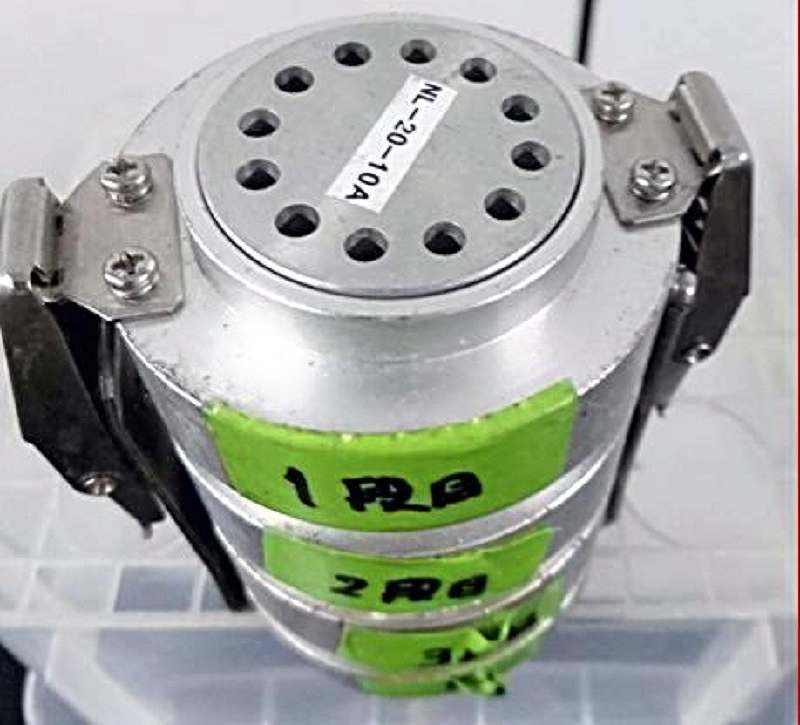
This microplastic particle found in the atmosphere has a diameter of 0.013 millimeters.
16:48 JST, May 11, 2022
The spread of microplastics not only in seas and rivers but in the air as well is a cause for concern, leading researchers in Japan to launch a fact-finding survey of the atmosphere.
The researchers have started monitoring the air in Japan and plan to conduct observations in Southeast Asia as early as this summer, as plastic pollution has become serious problem in that region.
Microplastics are defined as plastic particles 5 millimeters in size or smaller. The degradation of plastic bottles, plastic bags and other plastic products create these fragments, which are also components of abrasive powder.
Public research funds are supporting the researchers, who come from entities including Waseda University, Hiroshima University and the Japan Meteorological Agency’s Meteorological Research Institute.
The researchers will also study the negative effects of microplastics on the human body to consider future steps.
Microplastics have been found in oceans and rivers around the world, and there are concerns about their impact on ecosystems. They have also been confirmed in the atmosphere in countries such as Japan, China and France.
A 2019 survey by a team of researchers led by Waseda University Prof. Hiroshi Okochi found 5.2 microplastics per cubic meter in the atmosphere in the Shinjuku area of Tokyo. Most of the microplastics found were 0.03 millimeters or smaller, mainly particles of polyethylene terephthalate (PET), which is used in the production of plastic containers.
For the latest survey, the Environment Ministry is providing ¥100 million over three years from the fiscal year starting April 2021. Through the funds, the researchers have installed devices that collect airborne microplastics at more than 10 locations, including Tokyo, Osaka, Hokkaido and Mt. Fuji.
Preliminary studies found urban areas tend to have more airborne microplastics. A miniscule amount was also found near the summit of Mt. Fuji.
The researchers plan to install the devices at several more locations, including in countries such as Indonesia and Vietnam.
Experiments using animals are also underway at Hiroshima University and other entities in an aim to study the negative effects on living creatures when microplastics are consumed.
“We want to promote domestic and international observations and make use of them to devise measures against the spread of microplastics,” said Okochi, an environmental chemistry professor.
Kyushu University Prof. Atsuhiko Isobe, who is well versed in microplastics, regards these observations as important since there are still few surveys on airborne microplastics.
“The collection of a wide range of data will help us understand how microplastics move in the atmosphere,” the marine physics expert said.

A device used to collect airborne microplastics
"Science & Nature" POPULAR ARTICLE
-

Genome Study Reveals Milestone in History of Cat Domestication
-

Big Leap in Quest to Get to Bottom of Climate Ice Mystery
-

Japan Set to Participate in EU’s R&D Framework, Aims to Boost Cooperation in Tech, Energy
-

Paws on Parade: Nairobi’s Dogs Dazzle at ‘Pawchella’
-

Japan’s H3 Rocket Failed in Latest Launch, Says Official
JN ACCESS RANKING
-

Tokyo Economic Security Forum to Hold Inaugural Meeting Amid Tense Global Environment
-

Keidanren Chairman Yoshinobu Tsutsui Visits Kashiwazaki-Kariwa Nuclear Power Plant; Inspects New Emergency Safety System
-

Imports of Rare Earths from China Facing Delays, May Be Caused by Deterioration of Japan-China Relations
-

University of Tokyo Professor Discusses Japanese Economic Security in Interview Ahead of Forum
-

Japan Pulls out of Vietnam Nuclear Project, Complicating Hanoi’s Power Plans






















